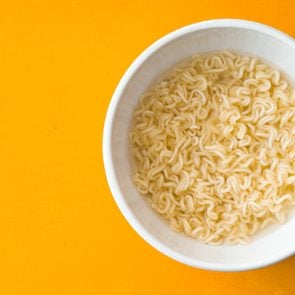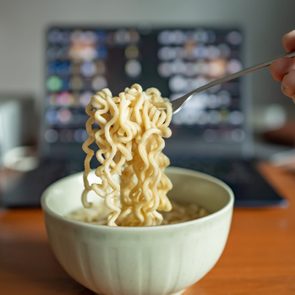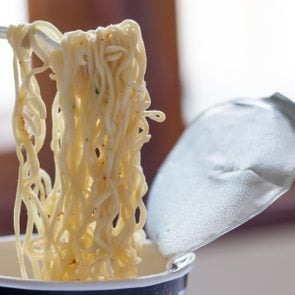Ramen Health Benefits—Are There Any? A Chef and Nutritionist Raise the Bar on Your Bowl
Updated: Mar. 08, 2022
Satisfy your ramen craving and get more nourishment (and flavor!) from your noodle bowl. Plus, a savvy list of kitchen staples for the ramen enthusiast who takes their passion seriously.
Our editors and experts handpick every product we feature. We may earn a commission from your purchases.
Readers of a certain age might remember Oodles of Noodles from the 1980s, when this product was touted as “the mostly noodle, noodle soup.” After school, at work, or inside your college dorm (ah, nostalgia), at some point you’ve almost certainly delighted in the ease of warming up a little water and then chasing ramen noodles into your mouth as they’ve playfully sprung from a spoon.
Since our younger days, ramen has only grown its following. In fact, one 2017 Korean study on ramen suggested that this dish boasts “the highest per capita instant noodle consumption worldwide.” What started as an early 20th Century Japanese twist on Chinese noodles—relatively high in fat, while satisfying against hunger—gained popularity in part because it was considered “stamina food” around lean times affected by war.
After World War II, that made sense: Ramen noodles are affordable, easy to make, they fill your belly… and, when you could use a tasty, textured bowl to lift the spirits in stressful times, ramen noodles are a reliable winner. But these days, general dietary needs tend to be different than they were a near-century ago. If you’re not aware of the pitfalls inside that noodle bowl, a routine ramen fix runs the risk of affecting your health.
How can you enjoy ramen on the regular while still staying healthy? As one doctor specializing in nutrition tells The Healthy, it’s all about getting creative.
Are ramen noodles bad for you?
For the minimal work it takes to prepare, a bowl of ramen has a way of making you want to sit back and forget your worries for a few minutes. (We might argue that is one possible health benefit of ramen.) The buzzkill is that many instant ramen products seriously lack in nutritional value, while packing in some definite diet “don’ts.” The trick to enjoying healthier ramen is to know exactly what to buy, and be armed with a little adventure to stock your crock so it’s steaming with added benefits.
What makes ramen unhealthy?
An initial challenge to overcome with some ramen is that the instant version is considered an ultra-processed food. Science has demonstrated time and again that regular consumption of highly processed foods can contribute to health problems such as atopic dermatitis (red, itchy skin rashes), obesity, and even some cancers, like cancer of the colon. For younger ramen lovers, one 2017 biology study suggested children with ADHD “are advised to avoid all food that may contain” some instant ramen ingredients.
Another point: Ramen noodles are often loaded with sodium, which is part of what makes them so flavorful. Why is high sodium a problem? Here’s why: It affects the amount of fluid around your heart, lungs, and legs. Extra fluid forces the heart to work harder, leading to high blood pressure, elevated risk for heart attack, and other heart problems.
Additionally, the palm oil, saturated fat, flavor enhancers, and additives in many packaged ramen products may include substances that are health hazards, such as monosodium glutamate (MSG), tertiary butylhydroquinone (TBHQ) and bisphenol A (BPA). Even that crackly, polystyrene packaging ramen often comes in contains compounds that in some cases may lead to cancer.
So, maybe stocking up on that bulk ramen carton at Costco isn’t your best bet—but some nutrition pros say the occasional serving of ramen can still be part of a healthy diet.
To make ramen healthier, pay attention to some general cautions, such as these:
- Carefully read the ingredient lists (and avoid consuming complicated ingredients you can’t pronounce).
- Watch out for the sodium content, keeping in mind the American Heart Association recommends a maximum of 2,300 milligrams (mg) per day.
- Combine ramen with a few healthy ingredients to create a nourishing meal that satisfies on all fronts. (Farther down, an award-winning chef offers some tempting suggestions.)
How many calories are in a bowl of ramen noodles?
If you’re watching your physique, the water retention from ramen’s sodium might not be the only aspect of this dish that can bloat your waistline. The number of calories in a bowl of ramen noodles will vary depending on portion size and the product, but a typical 43-gram serving of dry instant ramen noodles might contain around 200 calories.
However, some ramen fans routinely double the serving for a more plentiful bowl. Vegetable oil pours 12 grams of fat—six as saturated fat—into a 2.3-ounce serving of one recognizable brand, in addition to 38 grams of carbs.
Which leads to our next question…
Is ramen a bad carb?
Carbohydrates are essential macronutrients that your body converts into glucose (sugar) for energy. But what distinguishes a “good” carb from a “bad” carb? The Cleveland Clinic explains that there are three categories of carbs: Sugars, fiber, and starches. Sugars are further defined as being simple or complex carbs. This determines whether a food is a good carb, or a bad carb.
Complex carbs are healthy carbs. These are found in whole plant foods like fruits, vegetables, legumes and whole grains. These foods also contain important vitamins, minerals, and fiber that increase satiety and promote good health. They take longer to digest and are therefore less likely to spike your blood sugar, which increases satiety and provides balanced energy—all good things.
Simple carbs are the opposite. They do spike blood sugar, causing energy crashes and making you hungrier sooner after meals. This contributes to weight gain, as well as increases your risk of developing diabetes, heart disease, and high cholesterol. Simple carbs are found in processed, prepackaged foods that are stripped of nutritional value. Instant ramen noodles fall within this category.
So, one perspective in response to the question, “Is ramen a bad carb?” is that really, that could be up to you. Making a non-pre-packaged version at home by substituting healthier noodles is one way you can get good carbs out of your ramen bowl. (Below, we offer specific suggestions on a few of the best ramen noodles to try.)
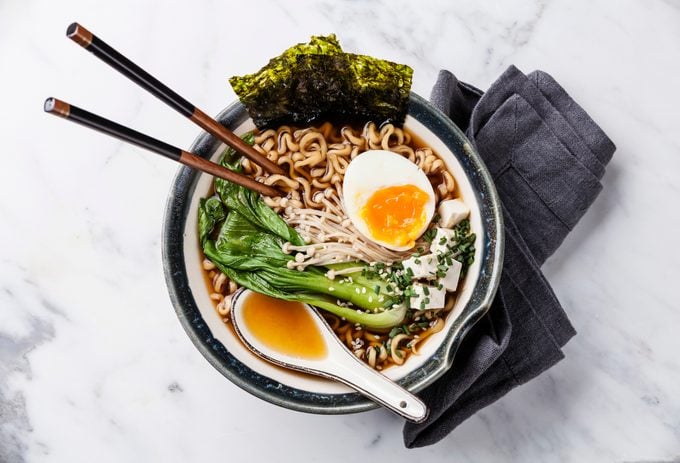
Tips to make ramen healthier
If you enjoy ramen (and really, who doesn’t?) but are concerned about the health implications, here are ways to boost the nutritional value of this convenient meal:
- Add vegetables: “You can create a healthier, affordable meal by adding inexpensive, rinsed canned beans and frozen veggies to it,” says Dr. Joan Salge Blake, nutrition professor at Boston University. Other options could be fresh or frozen veggies like cauliflower, spiralized zucchini, seaweed, kimchi, carrots, or spinach to inject your meal with nutrients. “These will add nutritious fiber, protein, vitamins, and minerals to the meal and reduce the amount of sodium and saturated fat,” Dr. Blake explains.
- Select lower-sodium products: You might be surprised at how easy it is to find low sodium ramen ingredients. We offer a couple options below.
- Double-check ingredients: If the ingredients sound like complicated synthetic chemicals, chances are good they are. Instead, see the next tip.
- Choose organic: Organic options are more likely free from harmful chemicals, as well as generally more nutritious.
- Make your own broth: This is a workaround to using the questionable flavor packets that come with many instant ramen noodles. Instead, make your own vegetable broth (our sibling site, Taste of Home, has a great ramen recipe that includes broth) and add your own herbs or seasonings to reduce the meal’s sodium content. (Again, a chef’s ideas fall below.)
How to make healthy ramen at home
John Ireland, the executive chef at the Saratoga Golf & Polo Club in Saratoga Springs, NY, occasionally features ramen on his menu, explaining how easy it is to elevate this popular meal. “The great thing about cooking [ramen] is that I can put whatever I feel like into a dish,” Ireland says. Kale, seaweed, and broccoli “are all simple suggestions,” while he adds that he prefers to cook them in a stir fry, along with tamari for extra flavor, before adding them to the bowl.
As for amplifying the flavor, Ireland suggests ginger, garlic, and scallion with a little hit of soy sauce to the broth. “I like to think that when people cook even something simple, they [can use] the best quality they can to feel better in the end,” he says.
It’s also possible to upgrade your noodles by opting for soba, udon, or brown rice noodles (we have a recommendation from shoppers below). These will taste similar to ramen, while offering more nutrition, a lower glycemic index, and a way to avoid wheat or other ingredients that cause some people health issues.
Shop Products To Make a Healthier Bowl of Ramen
Inspired to go all-in with your ramen game? You’ve so got this. Shop our list of vetted products, and sign up for The Healthy newsletter for more nutrition news you can use.
Lotus Foods Gourmet Lower Sodium Organic Millet/Brown Rice Ramen Noodles
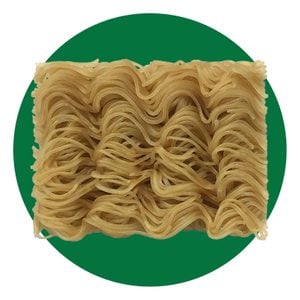
These brown rice noodles come recommended with thousands of five-star ratings, in part for being a popular shopping pick for non-wheat eaters. As Amazon shopper PublicYetPrivate noted, these noodles “have more flavor since they’re made with brown rice. But, it’s the texture that makes them seem like wheat noodles.”
This is also a ramen option with a small boost of digestion-friendly benefit, with two grams of fiber per one 35-gram serving.
Edward & Sons Not-Beef Boullion Cubes
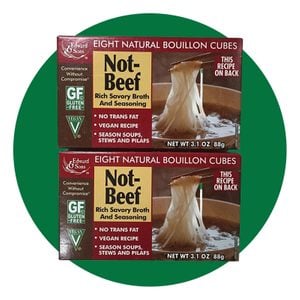
Healthier noodles call for a better broth, and more than 500 shoppers suggest this bouillon as a basic for your pantry. Reviewers say it delivers huge flavor, and going the extra heart-healthy step to split one of these cubes in half will limit your broth to around 465 milligrams of sodium, or approximately 20 percent of the recommended daily allowance.
A recent win with this brand is that, as an unnamed Amazon customer reports, Edward & Sons has removed the palm oil that some shoppers previously regarded as a flaw. “They got rid of the palm oil!” this customer said, after having bemoaned this ingredient three months prior. “I love this company!”
Dowan Deep Soup Bowls
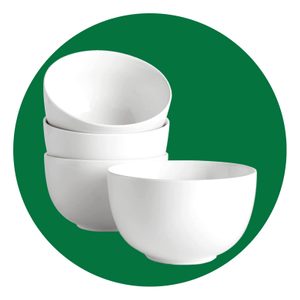
With more than 2,000 five-star reviews at press time, Dowan deep soup bowls are “large, sturdy,” and just the right size for everything from cereal and soup to chili and salad, according to reviewer SunshineAndWhiskey.
And, at a reported bowl depth of 3.5 inches, you might really get the sense that your ramen is a hug in a mug.
Hiware
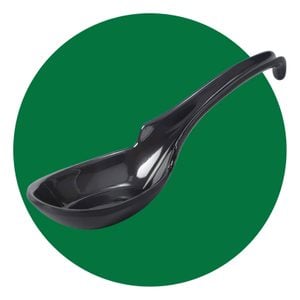
What caught our eye about this ramen spoon was its shape. The brand states that the spoon was designed ergonomically for soup lovers of all ages to use with ease, while reviewers suggest the “notch and hook” design makes it less likely you’ll have to fish for your spoon after it’s slipped inside your bowl.
Shoppers who have bought this product also say it holds noodles (and wontons) effectively without letting them constantly slide off the spoon. Storage is also said to be a positive feature of these ramen spoons—as Amazon reviewer Mike L. said: “Easy to use, easy to clean, stacks/nestles well.”
Glam Fields reusable bamboo chopsticks
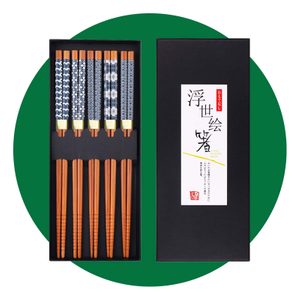
Another great way to grab those ramen noodles is with Glam Fields reusable bamboo chopsticks, which the brand says are treated with safe, food-grade lacquer that makes them washable and reusable for frequent use.
Also, some shoppers love the design. As Amazon reviewer Joanna reports: “Most reusable chopsticks are are smooth all the way down and they are not as ‘grippy’ as single use wooden ones. So the ridges at the bottom of these solve that problem. Recommend.”
It certainly doesn’t hurt that reusability makes these utensils eco-friendlier than tossing restaurant chopsticks in the trash.
U.S. Kitchen Supply Twill Mesh Strainers
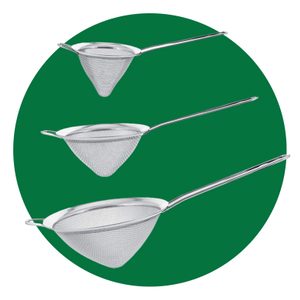
If you’re inspired by Chef Ireland’s suggestion to make your own broth, this set of mesh strainers could come in handy (and are a kitchen tool you’ll probably love having for washing fresh produce, steeping tea, straining juice pulp, and more).
One reason some shoppers recommend this product is, as Dianne R points out, “The cone shape directs the majority of the juice into the measuring cup instead of over the side like the broader, more bowl shaped strainers do.”
Comfee Pressure Cooker and 9-in-1 Kitchen Appliance
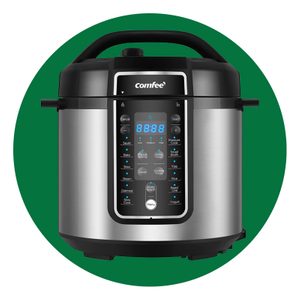
An instant pot-type appliance that can cook rice, bake cakes, stew soups and more could streamline plenty of meals. For ramen, the pressure cooker function in this Comfee 12-in-1 appliance will optimize your flavor factor—and, perhaps best of all when you’re hungry, shoppers say this appliance works fast. “It was quick, easy and delicious!” Ganbold said, while Chai added: “Since I bought this electric pressure cooker, it has really brought me a lot of convenience.”
If you’re on a ramen rage, read I Had Ramen Every Day for a Week—Here’s What Happened. Also, check out:

